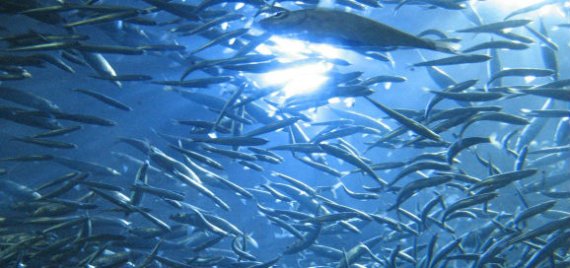Around the turn of the century there were suddenly large shoals of anchovies in the North Sea, without the aid of consultations or fishing quotas from Brussels. Slightly warmer seawater was enough to lure the fish northwards, thinks Kristina Raab, who is due to receive her PhD on 10 October for a study of this anchovy population explosion, conducted at Imares and the Aquaculture and Fisheries chair group.
Raab’s research ties in with international scientific interest in the big swings in anchovy population sizes. In the seas worldwide, enormous schools of sardines and anchovies take it in turns to dominate. So what factors determine these fluctuations? The answer to this question is of economic importance as well as academic interest: anchovies, sardines and other small fry account for half of the world’s fish catch.
The growth of young anchovies in their first season is related to the temperature
Kristina Raab
‘We see population fluctuations in the North Sea too,’ says Raab. ‘Although the numbers here are not nearly as large as in the oceans.’ Anchovy populations peaked at the end of the nineteen forties, only to collapse after that. The anchovy began to thrive again in the mid-nineteen nineties. Raab believes the current boom is largely due to the temperature of the seawater, which is higher than average, as it was in the nineteen forties, on account of a periodic climatic fluctuation. This effect may be reinforced by climate change. ‘The growth of young anchovies in their first season is related to the temperature,’ says Raab. But a higher water temperature also ensures that there are suitable breeding grounds in the German Bight, where it is otherwise usually too cold.
Raab and several international colleagues researched the origins of today’s North Sea anchovies as well. Were they Southern European fish, perhaps from the Bay of Biscay, which saw their chance when the North Sea warmed up? But the DNA profiles of the Spanish and the North Sea anchovies do not match, the team discovered. It would appear that a small population of anchovies manages to survive periods of low temperatures in the North Sea, reproducing and waiting for better times.
Fisheries are benefitting from the current boom, which does not seem to have a negative impact on sprats or herring, other zooplankton-eating fish. Anchovy fishing in the North Sea started about six years ago. Is it worth the bother? ‘I don’t think much of them salted, but you can buy fresh anchovies too at the Wageningen market. They are good.’

